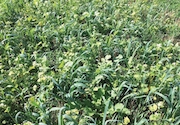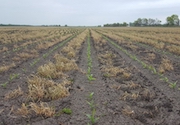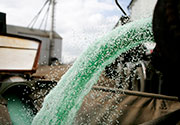| |
| |
_(DXR_GrainCarts)_728x90[1].jpg) |
_(DXR_GrainCarts)_300x50[1].jpg) |
| |
 |
|
MMMM d, yyyy |
|
| |
 Dry warm weather continues to advance harvest across the Prairies, especially in Saskatchewan which reported harvest numbers double the five year average. Overall, southern regions are reporting poorer crop conditions.
» Read more...
Dry warm weather continues to advance harvest across the Prairies, especially in Saskatchewan which reported harvest numbers double the five year average. Overall, southern regions are reporting poorer crop conditions.
» Read more...
The deadline to submit a letter of intent for the Canola Agronomic Research Program is Sept. 4, 2018. Priority areas for research include disease, fertility and soil health, integrated pest management and sustainability, and harvest and storage management.
» Read more...
Pea harvest is now complete, while soybean and dry bean harvest is underway in Manitoba, according to the latest bean report. Variable maturity rates in soybeans and very dry seed in dry bean are being reported as harvest issues.
» Read more...
|
| |
 |
| |
|
| |

Your photo could be featured on the cover of our December issue, our national edition that is distributed to farmers across Canada. Share what makes up your Top Crop - the challenges, successes and the ins and outs of your cropping season.
Show us your picturesque fields, the pesky insects you found this year, or your best photos from seeding and harvest. Photos will be accepted until October 24, 2018. Keep an eye out for additional prizes from our sponsor Meridian Manufacturing.
» Submit your photos here |
| |
|
| |
 Interest in cover crops is increasing despite the extra management requirements for producers. Not all cover crops are the same, and a producer’s reasons for planting cover crops determines what cover crop they use.
» Learn more
Interest in cover crops is increasing despite the extra management requirements for producers. Not all cover crops are the same, and a producer’s reasons for planting cover crops determines what cover crop they use.
» Learn more |
| |
 Researchers look into the use of cover crops in “shoulder seasons” - fall after harvest, and spring before planting - in order to help build resilient, productive soils and reduce erosion.
» Learn more
Researchers look into the use of cover crops in “shoulder seasons” - fall after harvest, and spring before planting - in order to help build resilient, productive soils and reduce erosion.
» Learn more |
| |
 |
| |
|
| |
 With fall applied ESN, your nitrogen is protected in the ground until spring. You don’t have to worry about lost time waiting to get equipment out into wet fields. It’s one less thing to worry about, plus you’ll know that your crops will have the nitrogen they need when they need it come spring.
» Learn more
With fall applied ESN, your nitrogen is protected in the ground until spring. You don’t have to worry about lost time waiting to get equipment out into wet fields. It’s one less thing to worry about, plus you’ll know that your crops will have the nitrogen they need when they need it come spring.
» Learn more |
|
 Growers that fall apply their nitrogen need look no further than ESN Smart nitrogen. Its polymer coating reduces nitrogen losses due to leaching, denitrification, and volatilization. Plus, ESN releases in response to soil temperature, closely matching the rates of crop demand, so your crops get the nitrogen they need when they need it.
» Learn more
Growers that fall apply their nitrogen need look no further than ESN Smart nitrogen. Its polymer coating reduces nitrogen losses due to leaching, denitrification, and volatilization. Plus, ESN releases in response to soil temperature, closely matching the rates of crop demand, so your crops get the nitrogen they need when they need it.
» Learn more |
| |
|
| |
|
|
| |
| |
_(DXR_GrainCarts)_728x90[1].jpg)
_(DXR_GrainCarts)_300x50[1].jpg)








